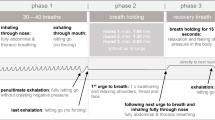Abstract
In 10 healthy male volunteers aged 19–20, spectral power of the beat-by-beat QT interval was measured at the Traube-Herring-Mayer (THM) band (0.05 to 0.15 Hz) when the subject was at rest and during atrial pacing. After resting in dorsal decubitus for 10 minutes, right atrial pacing was performed at a slight elevation above sinus rhythm as well as at 100 or at 110 beats per minute for 7 minutes each. In addition, during pacing at 100 or 110 bpm, the subject was required to perform a Kraepelin Arithmetic test. There was a statistically significant increase in QT spectral power at the THM band, while heart rate was maintained unchanged during the periods of mental stress versus rest. This experiment confirms the potential independence of the QT interval from heart rate and suggests that THM fraction of QT spectral power has a double subordination: during relaxed rest it follows mostly RR-fluctuation; during stress an RR-independent contribution is added, which presumably reflects the supra-normal sympathetic drive on the ventricles.
Similar content being viewed by others
References
Corley, K., Mauck, H.P., Shiel, F.O’M. (1979). Myocardial Dysfunction and Pathology Associated with Environmental Stress in Squirrel Monkey: Effect of Vagotomy and Propranolol,Psychophysiology, Amsterdam: Excp. Med. Abstract 16:554.
Fayn, J., Hamidi, S., Maison-Blanche, P., Coumel, P., Rubel, P. (1992). Quantitative Assessment of Beat-to-beat Variability in Ambulatory ECG Recordings,IEEE-EMBS 14th Annual International Conference, Paris, pp. 540–541.
Fei, L., Gill, S.J., Kartritsis, D., Camm, J.A. (1993). Abnormal Autonomic Modulation of QT Interval in Patients with Idiopathic Ventricular Tachycardia Associated with Clinically Normal Hearts.British Heart Journal, 69:311–314.
Huang, M.H., Ebey, J., Wolf, S. (1989). Response of the QT Interval of the Electrocardiogram during Emotional Stress,Psychosomatic Medicine 51:419–427.
Huang, M.H., Ebey, J., Wolf, S. (1989). Manipulating the QT Interval of the ECG by Cognitive Effort,The Pavlovian Journal of Biological Science 24(3):102–108.
Huang, M-H., Ebey, J., Wolf, S. (1991). Heart Rate-QT Interval Relationship during Postural Change and Exercise. A Possible Connection to Cardiac Contractility.Integrative Physiological and Behavioral Science 26:5–17.
Ionescu, D.-D., Dinca-Panaitescu, S., Filcescu, V., Enache, M., Negoescu, R. (1996). Time Constant of QT Adjustment to a Steady Heart Rate Obtained with Autonomic Blockade or Fixed Rate Atrial Pacing.Romanian Heart Journal VI(2):126.
Lown, B. (1990). Role of Higher Nervous Activity in Sudden Cardiac Death.Japanese Circulation Journal 54:581–599.
Members of the Force (1996). Heart Rate Variability. Standards of Measurement, Physiological Interpretation, and Clinical Use.European Heart Journal 17:354–381.
Negoescu, R.M., Porges, S.W. (1992). Short-term Oscillations in Systolic Time Intervals.IEEE-EMBS 12th Annual International Conference, Paris, 14:506–507.
Negoescu, R.M., Csiki, E., Pafuote, M., Wolf, S. (1993). Cortical Control of Sinus Arrhythmia in Man Studied by Spectral Analysis,Integrative Physiological and Behavioral Science 28:226.
Negoescu, R.M., Skinner, J., Wolf, S. (1993). Forebrain Regulation of Cardiac Function: Spectral and Dimensional Analysis of RR and QT Intervals,Integrative Physiological and Behavioral Science 28:331–342.
Nollo, G., Sperauza, G., Grasso, R., Bouamini, R., Maugiardi, L., Autolin, R. (1992). Spontaneous Beat-to-beat Variability of the Ventricular Repolarisation Duration.Journal of Electrocardiology 25(1):9–17.
Pagani, M., Mazzuero, G., Ferrari, A., Liberati, D. (1991). Sympathoragal Interaction during Mental Stress. A Study using Spectral Analysis of Heart Rate Variability in Healthy Control Subjects and Patients with a priori Myocardial Infraction. Supplement II.Circulation 83:43–51.
Porges, S.W., Bohrer, R.E. (1990). Analyses of Periodic Processes in Psychophysiological Research. In:Principles of Psychophysiology: Physical, Social, and Inferential Elements, ed. Cacioppo, J.T., Tassinary, L.G., Cambridge: Cambridge University Press.
Singh, L.P., Johnston, J., Sleigh, P., Marinho, M., Casadei, B., Hart, G. (1996), Waking Hour QT Interval Dynamics in Normal Subjects: Implications for the Circadian Pattern of Sudden Cardiac Death.European Heart Journal 17:279.
Singh, L.P., Sleigh, P., Musialek, P., Marinho, M., Hart, G. (1996). The Effect of betablockers on the Circadian Pattern of Rate Dependent Changes of the QT Interval in Myocardial Infarction.European Heart Journal 17:282.
Verrier, R.L., Hohnloser, S.H. (1987). How is the Nervous System Implicated in the Genesis of Cardiac Arrhythmias? In:Life Threatening Arrhythmias during Ischemia and Infarction, ed. Hearse, D., Manning, A., Janse, M. New York: Raven Press, pp. 153–168.
Author information
Authors and Affiliations
Rights and permissions
About this article
Cite this article
Negoescu, R., Dinca-Panaitescu, S., Filcescu, V. et al. Mental stress enhances the sympathetic fraction of QT variability in an RR-independent way. Integrative Physiological and Behavioral Science 32, 220–227 (1997). https://doi.org/10.1007/BF02688620
Issue Date:
DOI: https://doi.org/10.1007/BF02688620




